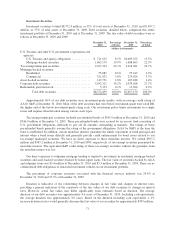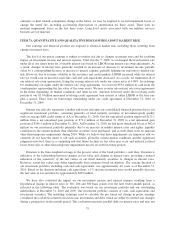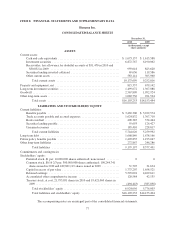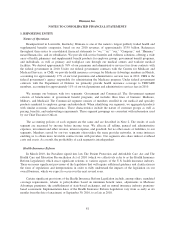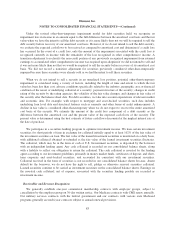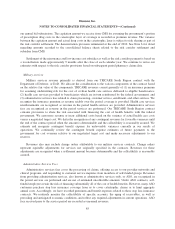Humana 2010 Annual Report Download - page 91
Download and view the complete annual report
Please find page 91 of the 2010 Humana annual report below. You can navigate through the pages in the report by either clicking on the pages listed below, or by using the keyword search tool below to find specific information within the annual report.Humana Inc.
NOTES TO CONSOLIDATED FINANCIAL STATEMENTS
1. REPORTING ENTITY
Nature of Operations
Headquartered in Louisville, Kentucky, Humana is one of the nation’s largest publicly traded health and
supplemental benefits companies, based on our 2010 revenues of approximately $33.9 billion. References
throughout these notes to consolidated financial statements to “we,” “us,” “our,” “Company,” and “Humana,”
mean Humana Inc. and its subsidiaries. We provide full-service benefits and wellness solutions, offering a wide
array of health, pharmacy and supplemental benefit products for employer groups, government benefit programs,
and individuals, as well as primary and workplace care through our medical centers and worksite medical
facilities. We derived approximately 76% of our premiums and administrative services fees from contracts with
the federal government in 2010. Under our federal government contracts with the Centers for Medicare and
Medicaid Services, or CMS, we provide health insurance coverage for Medicare Advantage members in Florida,
accounting for approximately 17% of our total premiums and administrative services fees in 2010. CMS is the
federal government’s agency responsible for administering the Medicare program. Under federal government
contracts with the Department of Defense we primarily provide health insurance coverage to TRICARE
members, accounting for approximately 11% of our total premiums and administrative services fees in 2010.
We manage our business with two segments: Government and Commercial. The Government segment
consists of beneficiaries of government benefit programs, and includes three lines of business: Medicare,
Military, and Medicaid. The Commercial segment consists of members enrolled in our medical and specialty
products marketed to employer groups and individuals. When identifying our segments, we aggregated products
with similar economic characteristics. These characteristics include the nature of customer groups as well as
pricing, benefits, and underwriting requirements. These segment groupings are consistent with information used
by our Chief Executive Officer.
The accounting policies of each segment are the same and are described in Note 2. The results of each
segment are measured by income before income taxes. We allocate all selling, general and administrative
expenses, investment and other revenue, interest expense, and goodwill, but no other assets or liabilities, to our
segments. Members served by our two segments often utilize the same provider networks, in some instances
enabling us to obtain more favorable contract terms with providers. Our segments also share indirect overhead
costs and assets. As a result, the profitability of each segment is interdependent.
Health Insurance Reform
In March 2010, the President signed into law The Patient Protection and Affordable Care Act and The
Health Care and Education Reconciliation Act of 2010 (which we collectively refer to as the Health Insurance
Reform Legislation) which enact significant reforms to various aspects of the U.S. health insurance industry.
There are many significant provisions of the legislation that will require additional guidance and clarification in
the form of regulations and interpretations in order to fully understand the impacts of the legislation on our
overall business, which we expect to occur over the next several years.
Certain significant provisions of the Health Insurance Reform Legislation include, among others, mandated
coverage requirements, rebates to policyholders based on minimum benefit ratios, adjustments to Medicare
Advantage premiums, the establishment of state-based exchanges, and an annual insurance industry premium-
based assessment. Implementation dates of the Health Insurance Reform Legislation vary from as early as six
months from the date of enactment, or September 30, 2010, to as late as 2018.
81


